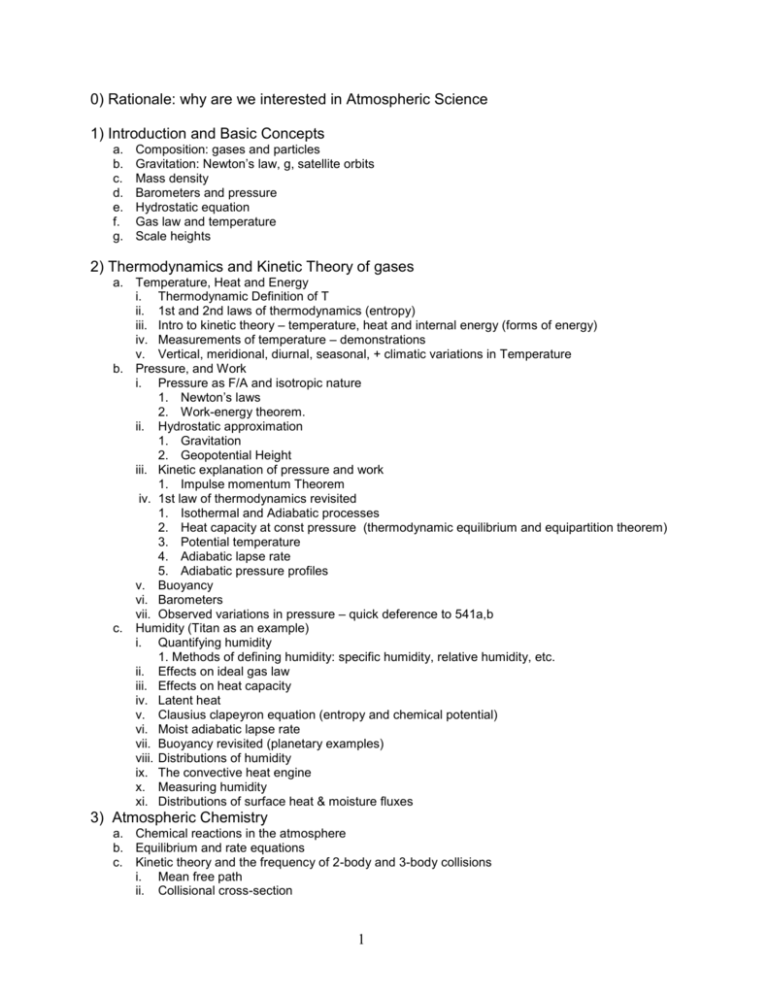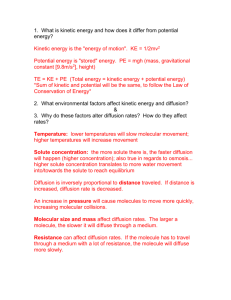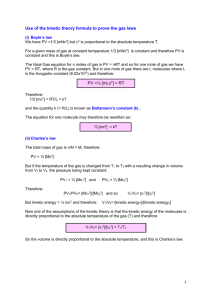1) Thermodynamics and Kinetic Theory of gases
advertisement

0) Rationale: why are we interested in Atmospheric Science 1) Introduction and Basic Concepts a. b. c. d. e. f. g. Composition: gases and particles Gravitation: Newton’s law, g, satellite orbits Mass density Barometers and pressure Hydrostatic equation Gas law and temperature Scale heights 2) Thermodynamics and Kinetic Theory of gases a. Temperature, Heat and Energy i. Thermodynamic Definition of T ii. 1st and 2nd laws of thermodynamics (entropy) iii. Intro to kinetic theory – temperature, heat and internal energy (forms of energy) iv. Measurements of temperature – demonstrations v. Vertical, meridional, diurnal, seasonal, + climatic variations in Temperature b. Pressure, and Work i. Pressure as F/A and isotropic nature 1. Newton’s laws 2. Work-energy theorem. ii. Hydrostatic approximation 1. Gravitation 2. Geopotential Height iii. Kinetic explanation of pressure and work 1. Impulse momentum Theorem iv. 1st law of thermodynamics revisited 1. Isothermal and Adiabatic processes 2. Heat capacity at const pressure (thermodynamic equilibrium and equipartition theorem) 3. Potential temperature 4. Adiabatic lapse rate 5. Adiabatic pressure profiles v. Buoyancy vi. Barometers vii. Observed variations in pressure – quick deference to 541a,b c. Humidity (Titan as an example) i. Quantifying humidity 1. Methods of defining humidity: specific humidity, relative humidity, etc. ii. Effects on ideal gas law iii. Effects on heat capacity iv. Latent heat v. Clausius clapeyron equation (entropy and chemical potential) vi. Moist adiabatic lapse rate vii. Buoyancy revisited (planetary examples) viii. Distributions of humidity ix. The convective heat engine x. Measuring humidity xi. Distributions of surface heat & moisture fluxes 3) Atmospheric Chemistry a. Chemical reactions in the atmosphere b. Equilibrium and rate equations c. Kinetic theory and the frequency of 2-body and 3-body collisions i. Mean free path ii. Collisional cross-section 1 d. Stratospheric photochemistry: Ozone + Chapman mechanism i. Basics of photochemistry – actinic fluxes + cross-sections – analogy with kinetic theory ii. Importance of nitrogen iii. Importance of CFCS e. Tropospheric chemistry: NOx, OH and VOCs f. Water and why homogeneous nucleation of droplets won’t happen (as segue) 4) Diffusion + Condensation (Under cloud physics and chemistry umbrellas) a. Using kinetic theory for diffusion of species b. Continuous diffusion equation and applications i. Connection to heat transfer equation c. Diffusion to a sphere d. Heat diffusion vs. vapor diffusion e. Droplet growth equation – sans Köhler theory 5) Basic fluid mechanics a. b. c. d. e. f. g. h. Navier-Stokes Equations (briefly) Acoustics (briefly) Stress tensor Kinetic formulation for dynamic (and kinematic) viscosities as diffusion of momentum Kinematics of fluid motion Dimensional analysis Reynolds’s # + Stokes flow High-Reynolds’s # flow i. Bernoulli’s equation ii. Basics of turbulence – Kolmolgorov lenghtscale, power-laws iii. Turbulent diffusion coefficients 6) The atmospheric aerosol + Particle mechanics a. Survey of aerosols in atmosphere b. Formality of size distributions – moments, etc. c. 2-phase flow mechanics – i. Drag forces + particle motion ii. Diffusion Coagulation iii. Graviational and Shear-induced coagulation 7) Cloud microphysics a. b. c. d. e. Köhler theory + CCN Growth of a population of droplets Cloud dynamics Ice Precipitation 8) Radiation a. b. c. d. e. f. g. The electromagnetic spectrum Measures of radiation and solid angle Blackbody laws Transitions and lines / Broadening / Atmospheric Spectra 2-stream IR radiative transfer + greenhouse effect The sun Single-Scattering i. Formal Rayleigh scattering ii. Mie Scattering/absorption iii. Geometric approximatioin h. Plane parallel Applications i. Aerosols / Optical depth ii. Clouds iii. Variation of sky radiance for thin atmosphere iv. 2-stream multiple scattering solutions - conservative v. 2-stream multiple scattering solutions – non-conservative + semi-infinite atmosphere approx. 2 9) Radiation budget + climate a. b. c. d. e. f. g. h. i. Simple radiation budget Equilibrium models Convection Advection Radiative Forcing + Feedback Geological records + Milankovich cycles Role of oceans Role of surface ice The true Gordian knot – feedbacks with biosphere 3








